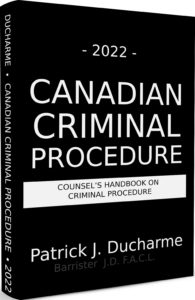
Duplicity refers to the technical fault in drafting a charge that unites more than a single offence in one count. Counts or charges in an information or indictment breaching the rule prohibiting duplicity will be seen as alleging more than one or perhaps even multiple offences in a single count. Amendments pursuant to section 601 usually erase the problem by breaking a single count into two or more counts, each alleging a singular offence.
Indictments charging conspiracy occasionally raise challenges that a conspiracy count has charged the accused with two or more conspiracies in a single count. A single conspiracy count may, in fact, have more than one illegal object, permitting a single count of conspiracy to contain allegations that the accused committed several crimes as part of the conspiracy. Similarly, one count of conspiracy may lead to proof at trial that there was actually more than one conspiracy. This rule of drafting requires counsel to distinguish between a single conspiracy having more than one object, and a single count of conspiracy that raises the issue of duplicity because it actually contains more than one conspiracy.
The charge of murder contains its own particular rule as to duplicity. Section 589 provides that no count that charges an indictable offence other than murder shall be joined in an indictment to a count that charges murder, unless the offence other than murder, arises out of the same transaction, or, the accused consents to the joinder of the counts.
The rule against duplicity is further complicated by subsection 590(1)(b) of the Code. It provides that a count is not objectionable by reason only that it is double or multifarious. This relates to a count referring to more than one legal offence or even multiple offences. At common law a count could not be framed in a double or multifarious manner. Each count had to deal with a single offence as a matter of law.
Originally, the single transaction rule and the rule against duplicity were designed to simplify the task of juries at a time when juries tried all criminal matters. The common-law rule against duplicity (two offences within the same count) or multiplicity (more than two offences within the same count) is a common-law procedural rule that arguably still applies to criminal pleadings because of subsection 8(3) of the Code. This subsection provides that every rule (or principle) of the common law that renders any circumstance a justification or excuse for an act or a defence to a charge continues in force and applies in respect of proceedings for an offence under the Code or any other Act of Parliament, except, in so far as they are altered by or are inconsistent with the Code or any other Act of Parliament.
Most courts will at least entertain an objection to a count in an information or an indictment that appears to be duplicitous or multiplicitous, either by quashing the count or by amending the count so as to contain only one legal charge. Although the old common-law rule has been compromised to some extent, as a matter of fairness, the court will usually ensure that the accused is not confused or misled by the wording of any particular count.

The above is the an excerpt of Patrick J Ducharme’s book, Canadian Criminal Procedure, available at Amazon or in bulk through MedicaLegal Publishing along with Criminal Trial Strategies.
Subscribe to Patrick Ducharme’s Youtube Channel
